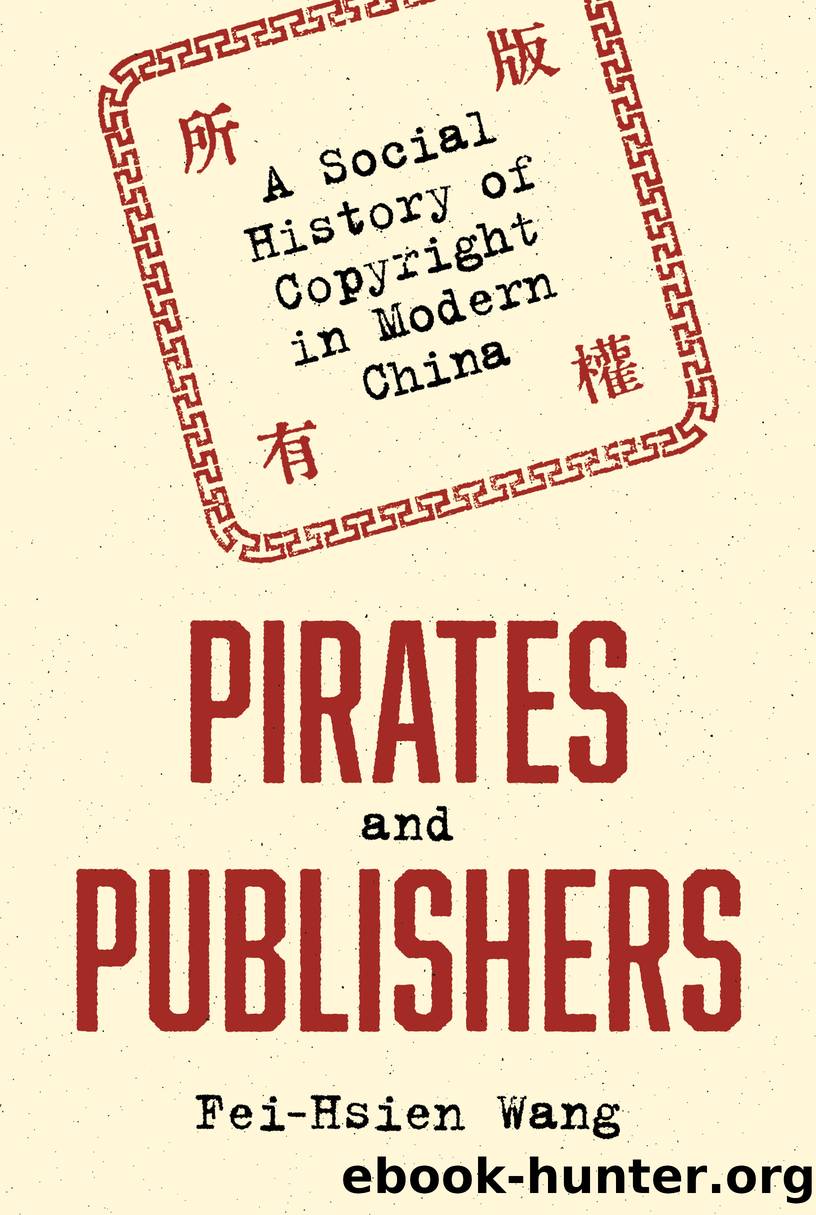Pirates and Publishers by Wang Fei-Hsien;

Author:Wang, Fei-Hsien;
Language: eng
Format: epub
Publisher: Princeton University Press
Published: 2019-07-18T00:00:00+00:00
Copycats
Copycatting was a common problem in early twentieth-century Shanghai when urban consumers were suddenly exposed to a wide range of new commodities and services. The front pages of Shanghaiâs major newspapers were frequently full of advertisements published by anxious booksellers, patent medicine manufacturers, and even insurance companies, condemning cunning copycats. They urged consumers to carefully identify bona fide trademarks and authorized retailers to ensure the authenticity of the products they bought. In the view of the SBG, copycats producing counterfeit titles that could mislead or confuse readers were an exceptionally abominable type of piracy, because copycats compromised not only the exclusivity of the genuine products but also the credibility of the brand name.
For some booksellers, protecting their brand was more important than recovering the profit lost to piracy. In October 1907, for instance, the Editorial Department of the Scientific Society (Kexuehui bianyibu) reported to the SBG that there was a copycat calling itself the âScientific Editorial Instituteâ (Kexue bianyiju), which was very similar to their name in Chinese. This copycat, they stated, had published a mathematics textbook entitled Suanshu jiaokeshu quanzhang (Full textbook of arithmetic), which was a pirated edition of their Chen Wen suanshu jiaokeshu (Chen Wenâs arithmetic textbook). The names of the two firms and the titles of these two books were so similar, they claimed, that their business had been noticeably affected, and the sales of their books were down. In response to the SBGâs inquiry, the copycat admitted that they had plagiarized the Editorial Department of the Scientific Societyâs books; they agreed to surrender the remainders and the shudi master copy of this title to the guild.62
But this was not what the Editorial Department of the Scientific Society wanted. Burning all the remainders wouldnât rehabilitate their brand name, which they considered to have been corrupted and compromised by the copycat. To restore this victimâs reputation, the SBG then demanded that the âScientific Editorial Instituteâ pay two hundred yuan in compensation for the damage they had done. The guild used half the money to publish a public announcement on the front pages of Shen bao and Eastern Times, two leading newspapers in Shanghai, for three consecutive days. In this statement, the SBG declared that the âScientific Editorial Instituteâ had confessed to being a copycat, and then endorsed the Editorial Department of the Scientific Society as the âauthenticâ entity.63 So pleased were they by the SBGâs announcement, the Editorial Department of the Scientific Society decided to donate the compensation they received from the copycat as an extra contribution to the guild.64
Download
This site does not store any files on its server. We only index and link to content provided by other sites. Please contact the content providers to delete copyright contents if any and email us, we'll remove relevant links or contents immediately.
| Africa | Americas |
| Arctic & Antarctica | Asia |
| Australia & Oceania | Europe |
| Middle East | Russia |
| United States | World |
| Ancient Civilizations | Military |
| Historical Study & Educational Resources |
The Story of China by Michael Wood(927)
Mr. Selden's Map of China by Timothy Brook(774)
Philippines--Culture Smart! by Culture Smart!(669)
Heroic Hindu Resistance To Muslim Invaders (636 AD to 1206 AD) by Sita Ram Goel(655)
Akbar: The Great Mughal by Ira Mukhoty(650)
The Meaning of India by Raja Rao(631)
Vedic Physics: Scientific Origin of Hinduism by Raja Ram Mohan Roy(624)
Food of India by unknow(616)
Banaras by Diana L. Eck(613)
India--Culture Smart! by Becky Stephen(602)
China Unbound by Joanna Chiu(601)
First Platoon by Annie Jacobsen(599)
Mao's Great Famine: The History of China's Most Devastating Catastrophe, 1958-1962 by Frank Dikötter(594)
North of South by Shiva Naipaul(588)
Insurgency and Counterinsurgency by Jeremy Black(564)
How to Be a Modern Samurai by Antony Cummins(562)
A History of Japan by R.H.P. Mason & J.G. Caiger(561)
The Genius of China: 3,000 Years of Science, Discovery, and Invention by Robert Temple(561)
The Digital Silk Road by Jonathan E. Hillman(549)
